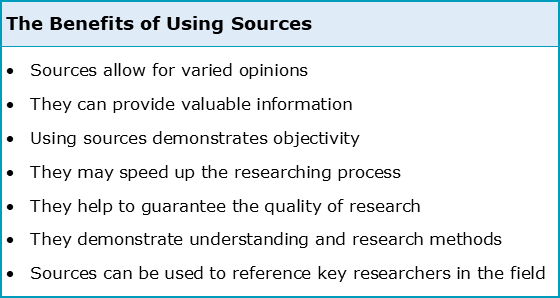How can I find academic sources effectively?

This is the first of three chapters about Finding Academic Sources. To complete this reader, read each chapter carefully and then unlock and complete our materials to check your understanding.
– Introduce the concept and benefits of academic sources
– Discuss the importance of using sources to support research
– Outline four common methods for finding academic sources
Before you begin reading...
-
video and audio texts
-
knowledge checks and quizzes
-
skills practices, tasks and assignments
Chapter 1
Learning how to find, use and create appropriate sources is a key component of being a successful academic. In truth, any student that wishes to successfully complete a university degree or that hopes to become a researcher in their working future must quickly learn how to locate, judge and best use the wide variety of sources on offer in order to create convincing academic assignments and research. However, for new students, the very initial concepts of what an academic source is as well as how to distinguish one source type from another are very real questions that must be answered and explored. This short three-chapter reader on finding academic sources therefore aims to deal with these questions in turn, turning finally to a discussion of why it’s important to differentiate primary and secondary sources in your writing.
What is a source, and why do academics need them?
University-level students are often quickly informed of the fact that they’ll be required to conduct research, write extended essays and present in front of their peers during an academic degree. Constructing a convincing or balanced argument about a topic is in fact one of the key skills of academia, and to do so competently requires the use of professionally published ideas, knowledge, research and findings – all of which may be found in what’s known as an academic source. To better understand what a source is exactly, we’ve provided the following definition:

It would appear then that a source may be composed of almost any text type that’s deemed appropriate for the purposes of academic research. While books, journal articles and websites might be the more traditional and common source types to use, even a post on a social-networking site such as Facebook, a photograph stored in a digital library or a famous political speech recorded during World War II could all be considered as being sources of academic investigation. The most important point here then is that sources provide the researcher with useful information that may help to create and support their academic assignment or publication.
But why is it so important for academics to rely on sources when conducting their research? To answer this question, consider first a published piece of research that has only one voice – the voice of its only author. Where did that author find their information, and can the evidence they present during their investigation be trusted? Could that author have personally conducted all the research that it would take to provide a comprehensive and convincing argument about that topic? And what about other academics, do they agree with these findings?
In addition to the benefits included in the table below, the inclusion of academic sources allows for many of the above questions to be answered:

Why should source types be identified?
As well as understanding what a source is and how one is useful during academic research, students should also be able to quickly identify the variety of source types on offer. Knowing whether you’re in possession of a journal article, a book chapter or an online blog will better prepare you for the value of that source and the kind of information it contains. A journal article, for example, should by its very nature be more trustworthy and academic than an open-source website such as Wikipedia or a personal blog. Through having an understanding of the commonalities of each source type, a researcher is often able to predict the difficulty of the text, the purpose of its creation and the likelihood of it being objective or biased.
In addition to better preparing the reader for the information contained within, there is another very practical reason that students should be able to quickly identify the type of source being used, and this is to do with referencing consistently and accurately. The way a reference is created and formatted is generally dependent upon two aspects: (1) the style of referencing and (2) the source type being used. Because of the importance of source identification, Chapter 2 later investigates this topic in much more detail.
Which methods are best for finding sources?
The final and most important aspect of this chapter is about knowing how to locate the most appropriate sources for your academic research. The realisation that there are in fact millions of sources available to a student can be quite a daunting one, particularly in the first year of tertiary education. Whether online or in a library, it’s no exaggeration that learning how to sort and sift through thousands of sources quickly and competently is a critical research skill to have. With this in mind, the following four methods have therefore been carefully explained for you below:
i) Using the Internet
Some source types such as blogs, websites, newspaper articles and government agencies may be quickly found by typing topical search-strings into popular search engines like Google or Baidu. Using this method, you may even discover the occasional academic journal article or digital textbook, although most quality sources such as these are often paywalled – available only through the subscription of a decent university library. While it is possible to find some useful sources when conducting internet searches, do be cautious here and remember that much of the information published online may be of questionable quality. If you’d like to learn more about how to judge the appropriacy, quality, recency and relevancy of an online source such as a blog or newspaper article, consider bookmarking our short reader on identifying source value.
ii) Navigating the Library
Libraries, particularly academic ones, are purposefully designed for assisting quality research and are one of the best ways of finding sources. The sources contained within a library are usually varied, high quality, well organised, and easily accessible, with librarians on call to answer queries and provide support. Most modern libraries not only offer physical books stacked in rows of shelving, but also contain many hundreds of thousands (or even millions) of digitised sources for a researcher to access, often available from the comfort of their own home. Learning how to use a library search engine is therefore another important research skill, and one that’s covered in more detail in our short reader on conducting digital searches.
iii) Following the Breadcrumbs
One of the most effective ways of finding relevant sources is by following the breadcrumbs of an existing source in your possession. What this means is, so long as you have one good-quality academic source (particularly one that references thoroughly, such as a journal article), you should be able to use that source to find other sources. To do this, check the source you have for a reference list, and then make a note of any interesting source titles. Hopefully, you’ll then be able to find those same sources by searching for their titles within an academic library catalogue.
iv) Asking Other Academics
Finally, consider asking other academics if they can recommend any good sources to get you started. Recommendations could come from a peer in your class, a student who’s a year or two above you, or (most likely) from your academic tutor. Once you have one good source about your topic, it should be easy enough to follow the breadcrumbs as described in point (iii) to other useful and relevant sources.
Now that we’ve discussed what a source is and why such sources are extremely useful for academics, Chapter 2 on this topic focusses more specifically on how to identify sources – particularly those commonly used in academic research.
Downloadables
Once you’ve completed all three chapters about finding academic sources, you might also wish to download our beginner, intermediate and advanced worksheets to test your progress or print for your students. These professional PDF worksheets can be easily accessed for only a few Academic Marks.
Collect Academic Marks
-
100 Marks for joining
-
25 Marks for daily e-learning
-
100-200 for feedback/testimonials
-
100-500 for referring your colleages/friends